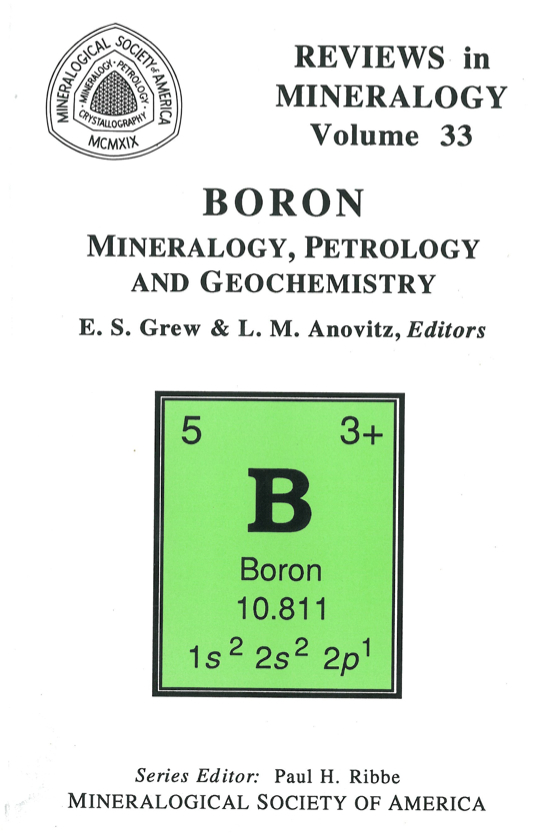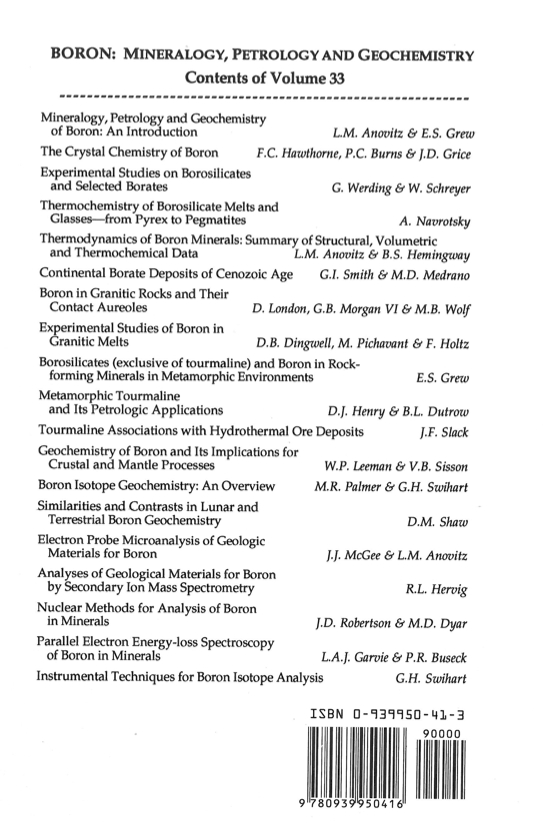

Mineralogical Society of America, Founded December 30, 1919
Order Publications Online (25% discount for MSA, CMS and GS members, except shipping)
MinPubs.org Pay-Per-View GeoScienceWorld Pay-Per-View


1996, 2002 i-xx + 864 pages. ISBN 0-939950-41-3; ISBN13 978-0-939950-41-6
At the time of the first printing (1996), interest in the element boron was growing rapidly. We felt that it was an opportune moment to ask investigators active in research on boron to review developments in their respective fields so that readers could learn what was-and wasn't-known about boron and its minerals, geochemistry and petrology.
Since 1996, interest in boron has, if anything, increased, and continued demand for the Reviews in Mineralogy "boron bible" has motivated the Mineralogical Society of America to reprint the volume. Demand is reflected in citations, and according to ISI's Science Citation Index, the number of citations since publication to the volume is about 380, with some individual chapters having been cited as many as 44 times.
In preparation for this printing, authors of 15 of the 19 original chapters have updated, corrected or added to their chapters within the constraints that no pages be added. Most addenda are bibliographies of literature published since 1996; a few also include summaries of significant findings. Addenda for each chapter follow the chapter, except for those for Chapters 1 and 2, which are merged onto pages 115-116 and 385. A table of new B-minerals since 1996 is given on p. 28, and many modifications were made to the table (p. 7-27) of B-minerals known prior to 1996 (corrections to formulae, mineral names, localities, etc.). Similar up-datings of Table 1 (p. 223) in Chapter 5 and numerous tables in Chapter 9 (p. 387) were undertaken, and Figure 15 in Chapter 11 (p. 619), which-embarrassingly-was missing from the first printing, has been supplied. Addenda to Chapter 13 are introduced on p. 744 and completed on p. 863 and 864.
The following salient developments in research related to B are mentioned in the addenda:
One of the major questions facing the use of hydrogeochemical models is whether or not they can be used with confidence to predict future evolution of groundwater systems. There is much controversy concerning the validity and uncertainties of non-reactive fluid flow systems. Adding chemical interaction to these flow models only confounds the problem. Although such models may accurately integrate the governing physical and chemical equations, many uncertainties are inherent in characterizing the natural system itself. These systems are inherently heterogeneous on a variety of scales rendering it impossible to know precisely the many details of the flow system and chemical composition of the host rock. Other properties of natural systems such as permeability and mineral surface area, to name just two, may never be known with any great precision, and in fact may be unknowable. Because of these uncertainties, it remains an open question as to what extent numerical models of groundwater flow and reactive transport wilI be useful in making accurate quantitative predictions. Nevertheless, reactive transport models should be able to predict the outcome for the particular representation of the porous medium used in the model.
Finally, it should be mentioned that numerical models are often our only recourse to analyze such environmental problems as safe disposal of nuclear waste where predictions must be carried out over geologic time spans. Without such models it would be impossible to analyze such systems, because they involve times too long to perform laboratory experiments. The results of model calculations may affect important political decisions that must be made. Therefore, it is all the more important that models be applied and tested in diverse environments so that confidence and understanding of the limitations and strengths of model predictions are understood before irreversible decisions are made that could adversely affect generations to come.
Edward S. Grew, Orono, Maine, USA
Lawrence M. Anovitz, Oak Ridge, Tennessee, USA
April 25, 2002
Title page
p. i
Copyright
p. ii
Foreword
p. iii
Preface to Second Printing, 2002
p. iv
Table of Contents
p. v - xx
Chapter 1. Mineralogy, Petrology and Geochemistry of Boron: An Introduction
by Lawrence M. Anovitz and Edward S. Grew, p. 1 - 40
Chapter 2. The Crystal Chemistry of Boron
by Frank C. Hawthorne, Peter C. Burns, and Joel D. Grice, p. 41 - 116
Chapter 3. Experimental Studies on Borosilicates and Selected Borates
by G. Werding and Werner Schreyer, p. 117 - 164
Chapter 4. Thermochemistry of Borosilicate Melts and Glasses - from Pyrex to Pegmatites
by Alexandra Navrotsky, p. 165 - 180
Chapter 5. Thermodynamics of Boron Minerals: Summary of Structural, Volumetric and Thermochemical Data
by Lawrence M. Anovitz and Bruce S. Hemingway, p. 181 - 262
Chapter 6. Continental Borate Deposits of Cenozoic Age
by George I. Smith and Marjorie D. Medrano, p. 263 - 298
Chapter 7. Boron in Granitic Rocks and Their Contact Aureoles
by David London, George B. Morgan, VI, and Michael B. Wolf, p. 299 - 330
Chapter 8. Experimental Studies of Boron in Granitic Melts
by Donald B. Dingwell, Michel Pichavant, and François Holtz, p. 331 - 386
Chapter 9. Borosilicates (Exclusive of Tourmaline) and Boron in Rock-forming Minerals in Metamorphic Environments
by Edward S. Grew, p. 387 - 502
Chapter 10. Metamorphic Tourmaline and Its Petrologic Applications
by Darrell J. Henry and Barbara L. Dutrow, p. 503 - 558
Chapter 11. Tourmaline Associations with Hydrothermal Ore Deposits
by John F. Slack, p. 559 - 644
Chapter 12. Geochemistry of Boron and Its Implications for Crustal and Mantle Processes
by William P. Leeman and Virginia B. Sisson, p. 645 - 708
Chapter 13. Boron Isotope Geochemistry: An Overview
by Martin R. Palmer and George H. Swihart, p. 709 - 744
Chapter 14. Similarities and Contrasts in Lunar and Terrestrial Boron Geochemistry
by Denis M. Shaw, p. 745 - 770
Chapter 15. Electron Probe Microanalysis of Geologic Materials for Boron
by James J. McGee and Lawrence M. Anovitz, p. 771 - 788
Chapter 16. Analyses of Geological Materials for Boron by Secondary Ion Mass Spectrometry
by Richard L. Hervig, p. 789 - 804
Replacement for Page 789 (pdf)
Chapter 17. Nuclear Methods for Analysis of Boron in Minerals
by J. David Robertson and M. Darby Dyar, p. 805 - 820
Chapter 18. Parallel Electron Energy-loss Spectroscopy of Boron in Minerals
by Laurence A. J. Garvie and Peter R. Buseck, p. 821 - 844
Chapter 19. Instrumental Techniques for Boron Isotope Analysis
by George H. Swihart, p. 845 - 862
Chapter 13, addendum
by Martin R. Palmer and George H. Swihart, p. 863 - 864
Errata. The Second Printing (2002) contained numerous corrections and additions to the original (1996) text. Unfortunately, changes to several chapters were inadvertently misplaced and thus were not included in this printing. They are detailed in (pdf)